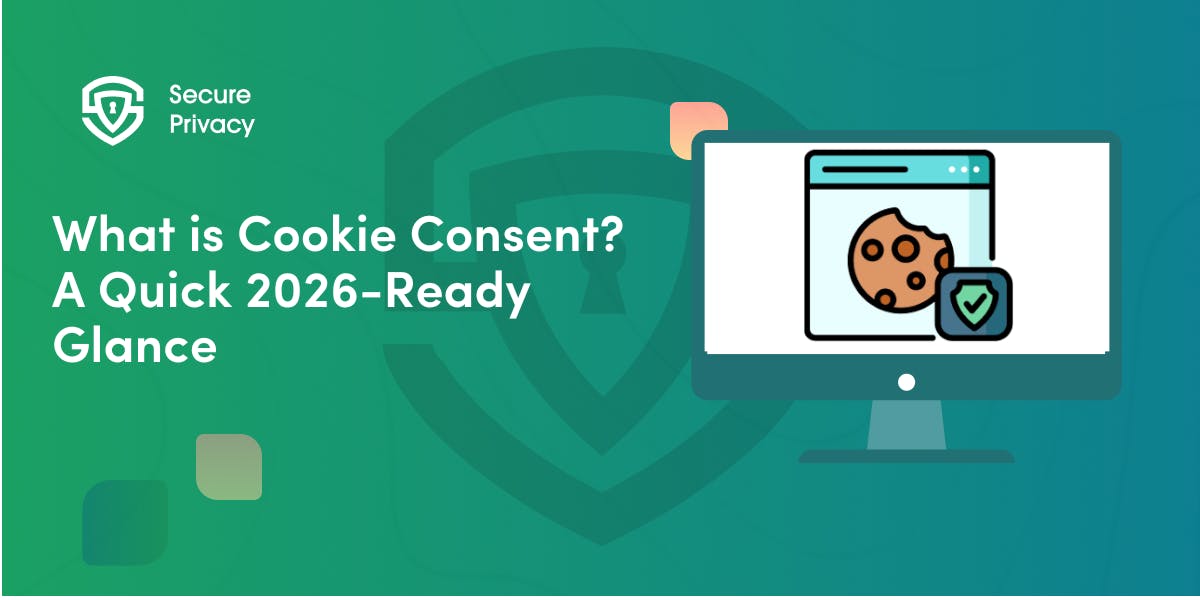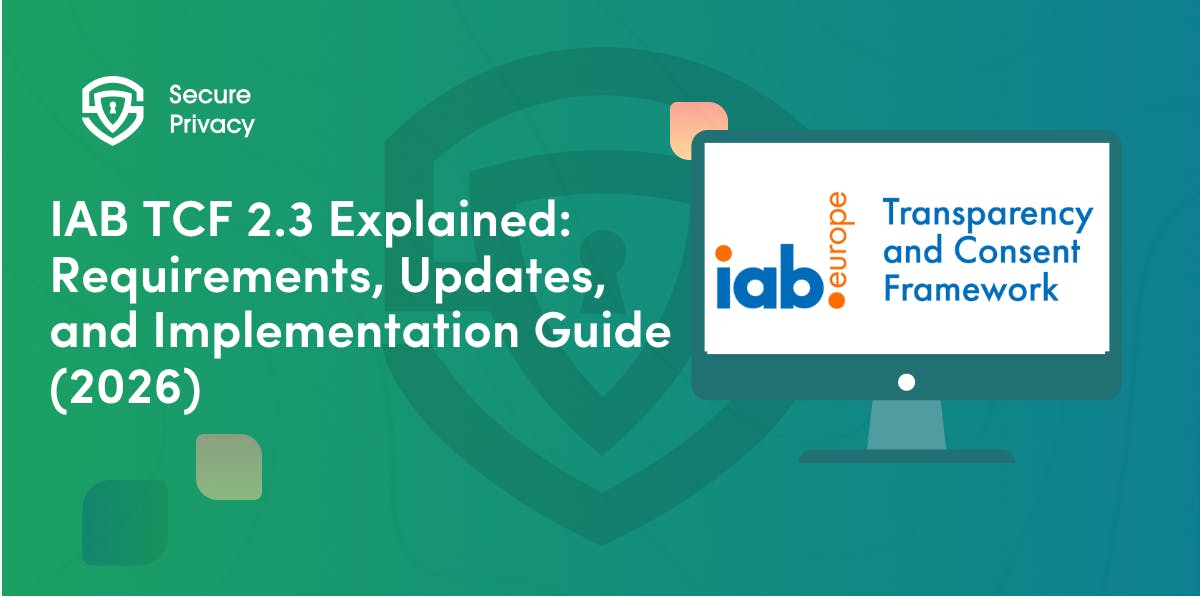Mobile App Consent for iOS: A Deep Dive (2025) [Updated July 2025]
iOS app consent has evolved into a sophisticated ecosystem where regulatory compliance, technical innovation, and user experience converge. As App Store rejection rates climb and privacy enforcement intensifies, understanding consent management for iOS apps has become critical for sustainable app success.
Apple's ecosystem demands platform-specific strategies that go beyond generic mobile solutions. The integration of App Tracking Transparency, Privacy Manifests, and stringent app review processes creates unique challenges that require specialized technical approaches and deep understanding of Apple's philosophy regarding iOS privacy compliance 2025.
This guide examines the current landscape of consent in iOS apps, providing actionable insights for developers, product managers, and professionals navigating the complex intersection of legal requirements and Apple's evolving framework in 2025.
Regulatory and Platform Landscape
Global Regulations create overlapping requirements for iOS apps operating across multiple jurisdictions. GDPR mandates explicit consent for non-essential data processing including analytics and advertising, while requiring withdrawal mechanisms equally accessible as consent granting. California's CCPA/CPRA demands opt-out mechanisms for data sales and sharing, creating additional implementation needs for developers serving US markets.
Emerging Regional Frameworks add complexity layers. Brazil's LGPD requires specific flows for cross-border data transfers, while China's PIPL demands separate permissions for biometric data and location tracking. These multi-jurisdictional requirements necessitate geo-aware systems that adapt automatically to user locations.
While this guide focuses on iOS-specific requirements, Android and Android TV-based devices operate under distinctly different consent architectures, requiring separate technical implementations despite serving the same regulatory frameworks. Moreover, tvOs has its own consent challenges.
Apple as Data Protection Enforcer has positioned itself beyond platform provider to active guardian. The company rejected 12% of App Store submissions in Q1 2025 for Privacy Manifest violations, demonstrating that implementation affects app distribution directly. Nutrition Labels now influence 94% of user download decisions, transforming data protection from checkbox to competitive differentiator.
Financial Impact of Data Protection Decisions has become measurable. Apps with ATT opt-in rates below 30% lose an average of 58% of advertising revenue according to 2025 AppsFlyer analysis. This direct monetization impact makes effective iOS CMP implementation a business imperative rather than purely regulatory requirement.
App Tracking Transparency: Foundation of iOS Privacy Compliance 2025
ATT Framework Evolution has matured since its 2021 introduction, with 2025 updates requiring specific third-party data recipient disclosure. Generic "tracking for ads" notifications must now specify actual partners: "Share with Meta for advertising" or "Share with Google for analytics." This transparency requirement affects both technical implementation and user experience design.
Mandatory ATT Triggers occur when apps access IDFA, implement cross-app tracking, or share user data with data brokers for advertising purposes. However, common misconceptions persist about ATT scope—the framework doesn't replace GDPR requirements or eliminate need for additional controls within apps.
Technical Implementation Requirements involve careful timing and context consideration. Apple's Human Interface Guidelines mandate that ATT prompts use non-technical language at eighth-grade reading level, avoid interrupting critical user flows, and present balanced visual hierarchy between acceptance and rejection options.
Performance Implications extend beyond user choice percentages. Apps implementing pre-prompt education see 40-60% higher ATT acceptance rates compared to immediate system prompts. This educational approach requires additional development resources but provides substantial business value through improved data access.
Strategic Consent Request Timing
Recommended Flow begins with contextual in-app education before presenting ATT prompts. Users need clear understanding of personalization benefits and data usage before making decisions that significantly impact app functionality and business model sustainability.
Pre-Prompt Design Strategies should explain tracking value propositions clearly without manipulation. Effective approaches include demonstrating personalized content examples, showing relevant advertisement benefits, and connecting data usage to specific app improvements users will experience.
Granular Architecture extends beyond ATT to include analytics permissions, personalization preferences, and marketing communications. This layered approach provides users granular control while enabling apps to maintain essential functionality even when broad tracking is declined.
Conditional Logic Implementation determines optimal ATT presentation timing based on user engagement levels, feature usage patterns, and onboarding completion status. Apps showing ATT after users experience core value propositions achieve significantly higher acceptance rates.
SDK Consent Orchestration in iOS
Third-Party SDK Management requires implementing permission-aware initialization patterns that prevent unauthorized tracking before permissions are granted. Popular SDKs like Firebase Analytics and Facebook SDK automatically begin data collection upon app launch unless specifically configured otherwise.
Technical Implementation Patterns include consent wrapper classes that control SDK initialization, configuration flags that enable/disable tracking features, and observer patterns that respond immediately to consent changes. These approaches ensure that user privacy choices are enforced consistently across all app components.
Dynamic SDK Configuration enables real-time adjustment of tracking capabilities based on current consent status. When users modify privacy preferences, apps must immediately reflect these changes across all initialized SDKs without requiring app restart or significant user experience disruption.
Consent State Synchronization becomes critical when managing multiple data processors and analytics providers. Modern iOS CMP solutions provide centralized consent state management that automatically propagates user decisions across all integrated services while maintaining audit trails for compliance documentation.
Native iOS Privacy UX Design
SwiftUI Consent Components provide native feel while maintaining compliance requirements. Modern consent interfaces use declarative UI patterns that integrate seamlessly with app design languages while meeting Apple's accessibility and usability standards.
Accessibility Compliance extends beyond basic VoiceOver support to include dynamic text sizing, high contrast mode compatibility, and motor accessibility for users with limited dexterity. Consent interfaces must support minimum 16-point font sizes and provide alternative interaction methods.
Localization Requirements involve more than text translation—cultural privacy expectations vary significantly across regions. EU users expect granular control options, while users in other regions may prefer simplified binary choices that reduce decision complexity.
Performance Optimization ensures consent interfaces load quickly and respond smoothly to user interactions. Heavy consent modals that delay app startup or consume excessive memory negatively impact user experience and may lead to immediate app deletion.
Compliance Logging and Backend Integration
Audit-Ready Consent Records must include timestamps, user identifiers, consent versions, specific permissions granted or denied, and geographical context. These records support regulatory investigations and demonstrate ongoing compliance efforts to supervisory authorities.
Backend Synchronization ensures consent decisions propagate immediately across web platforms, server-side processing, and third-party integrations. Users expecting consistent privacy treatment across touchpoints will abandon apps that fail to maintain synchronized consent state.
Data Subject Rights Management has expanded with new requirements. Secure Privacy now offers DSAR forms for mobile apps, enabling streamlined processing of user access requests, data portability demands, and deletion requirements directly within iOS applications. This integration simplifies compliance workflows while providing users convenient self-service options.
Consent Withdrawal Processing must execute immediately and completely. When users revoke permissions, apps must stop all associated data processing, delete unnecessary retained data, and confirm completion to users within reasonable timeframes typically measured in hours rather than days.
x
Privacy Manifest and SDK Reporting Requirements
Privacy Manifest Compliance has become mandatory for all App Store submissions since May 2024. Developers must declare all data types collected, justify API usage with specific codes, and disclose third-party SDKs with data access capabilities.
SDK Transparency Requirements demand detailed disclosure of data collection practices for all integrated libraries. Popular analytics and advertising SDKs now require explicit declaration of tracking capabilities, data sharing practices, and retention policies within app manifests.
App Store Review Process actively screens submissions for Privacy Manifest completeness and accuracy. Inconsistencies between declared practices and actual app behavior result in immediate rejection, requiring developers to maintain precise documentation of all data handling activities.
Automated Compliance Checking tools help developers identify potential manifest violations before submission. These tools scan app binaries for unauthorized API usage, undeclared data collection, and SDK configuration issues that commonly cause App Store rejections.
Choosing an iOS CMP Solution
Native iOS Integration should provide seamless SwiftUI components, comprehensive ATT support, and native consent enforcement for popular SDKs. Solutions requiring web views or cross-platform compromises often fail to meet Apple's user experience standards.
Developer Experience Priorities include comprehensive Swift documentation, sample implementations for common use cases, responsive technical support, and regular updates aligned with iOS release cycles. Poor developer experience leads to implementation delays and increased compliance risks.
Customization Capabilities must balance brand consistency with Apple's design guidelines. The best iOS CMP solutions provide extensive visual customization while ensuring compliance with accessibility requirements and platform conventions.
Multi-Language Support extends beyond interface translation to include legal framework adaptation for different jurisdictions. Effective solutions automatically adjust consent requirements based on user location while maintaining consistent user experience quality.
Future Outlook: Apple Privacy Enforcement Evolution
Increasing Enforcement Intensity will continue as Apple strengthens its privacy positioning against competitors. Expect more granular disclosure requirements, stricter SDK review processes, and enhanced user control over cross-app data sharing.
AI and Personalization Consent represents emerging complexity as machine learning capabilities expand. Future iOS versions will likely require specific permissions for AI training data usage, algorithmic profiling, and predictive personalization features.
Cross-Platform Privacy Interoperability may develop as regulatory pressure increases for consistent privacy experiences across devices and platforms. Apple's potential adoption of industry standards could simplify compliance for developers managing multi-platform apps.
Privacy-Preserving Innovation will drive new technical approaches that maintain personalization capabilities while reducing data collection requirements. Differential privacy, on-device processing, and federated learning represent technological evolution toward privacy-by-design implementation.
Building Sustainable iOS Privacy Strategy
The iOS privacy landscape demands proactive strategy rather than reactive compliance. Successful apps view consent management as fundamental user experience component worthy of substantial design and engineering investment.
Technical Excellence requires understanding Apple's privacy philosophy deeply and implementing solutions that exceed minimum requirements. Apps that treat privacy as core feature rather than compliance burden achieve better user trust and business outcomes.
User-Centric Design should make privacy choices clear, meaningful, and respectful of user time and attention. The most successful iOS apps integrate consent seamlessly into onboarding flows while providing ongoing privacy control accessibility.
Competitive Advantage emerges from superior privacy implementation that builds user trust and reduces regulatory risk. As privacy enforcement intensifies, compliance excellence becomes sustainable competitive differentiation.
Ready to implement world-class iOS app consent management? Secure Privacy's native iOS SDK provides comprehensive ATT integration, granular consent controls, and automated compliance documentation designed specifically for Apple's ecosystem requirements.
Frequently Asked Questions
What makes iOS app consent different from web-based consent management?
iOS app consent involves platform-specific requirements including App Tracking Transparency integration, Privacy Manifest compliance, and native UI components. Unlike web consent, iOS apps must work within Apple's strict review process and design guidelines while supporting device-specific features like biometric authentication and location services.
How does App Tracking Transparency relate to GDPR compliance requirements?
ATT focuses specifically on cross-app tracking and IDFA access, while GDPR requires consent for any non-essential personal data processing. Apps need both ATT compliance for Apple's requirements and separate GDPR consent mechanisms for legal compliance. These frameworks complement rather than replace each other.
What are the key features to look for in an iOS CMP solution?
Essential features include native SwiftUI components, comprehensive ATT integration, automatic SDK consent enforcement, multi-language support, Privacy Manifest compatibility, and audit-ready consent logging. The solution should also provide seamless backend synchronization and responsive developer support.
How should developers handle consent for users traveling between different jurisdictions?
Implement geo-aware consent systems that automatically detect user location and apply appropriate regulatory frameworks. Store user preferences securely while respecting local data residency requirements. Consider using APIs that provide real-time location-based compliance guidance for traveling users.
What are the consequences of iOS privacy compliance failures?
Consequences include App Store rejection, removal of existing apps, loss of advertising revenue, regulatory fines up to €20 million under GDPR, and severe reputational damage. Apple's active enforcement means privacy violations affect app distribution immediately, making compliance essential for business continuity.
How can developers optimize ATT opt-in rates without violating Apple's guidelines?
Focus on education rather than persuasion by clearly explaining personalization benefits, showing relevant examples of improved user experience, and timing prompts after users experience app value. Avoid dark patterns, emotional language, or visual manipulation while providing genuine value propositions for data sharing.
Get Started For Free with the
#1 Cookie Consent Platform.
No credit card required

What is Cookie Consent? A Quick 2026-Ready Glance
Your website loads. Cookies track users. But without proper cookie consent, you're violating GDPR — risking fines up to €20 million or 4% of global revenue. Cookie consent is the legally required mechanism by which websites obtain explicit user approval before deploying non-essential tracking technologies. This requirement stems from GDPR Article 4(11) and the ePrivacy Directive, mandating that consent must be freely given, specific, informed, and unambiguous.
- Legal & News

DSAR Tools Explained: Best Software for Automating Privacy Requests
You're drowning in data subject access requests. Manual searches through dozens of systems miss regulatory deadlines and expose organizations to fines starting at $2,500 per violation. The solution? DSAR tools — purpose-built software that automates the entire process of responding to data subject access requests, from intake to delivery.
- Legal & News

IAB TCF 2.3 Explained: Requirements, Updates, and Implementation Guide (2026)
Your ad revenue dropped 40% overnight. Google stopped bidding on your inventory. Your DSP partners flagged your traffic as non-compliant. The culprit? An outdated TCF 2.2 consent string after the February 2026 enforcement deadline.
- Legal & News
- Cookie Consent

